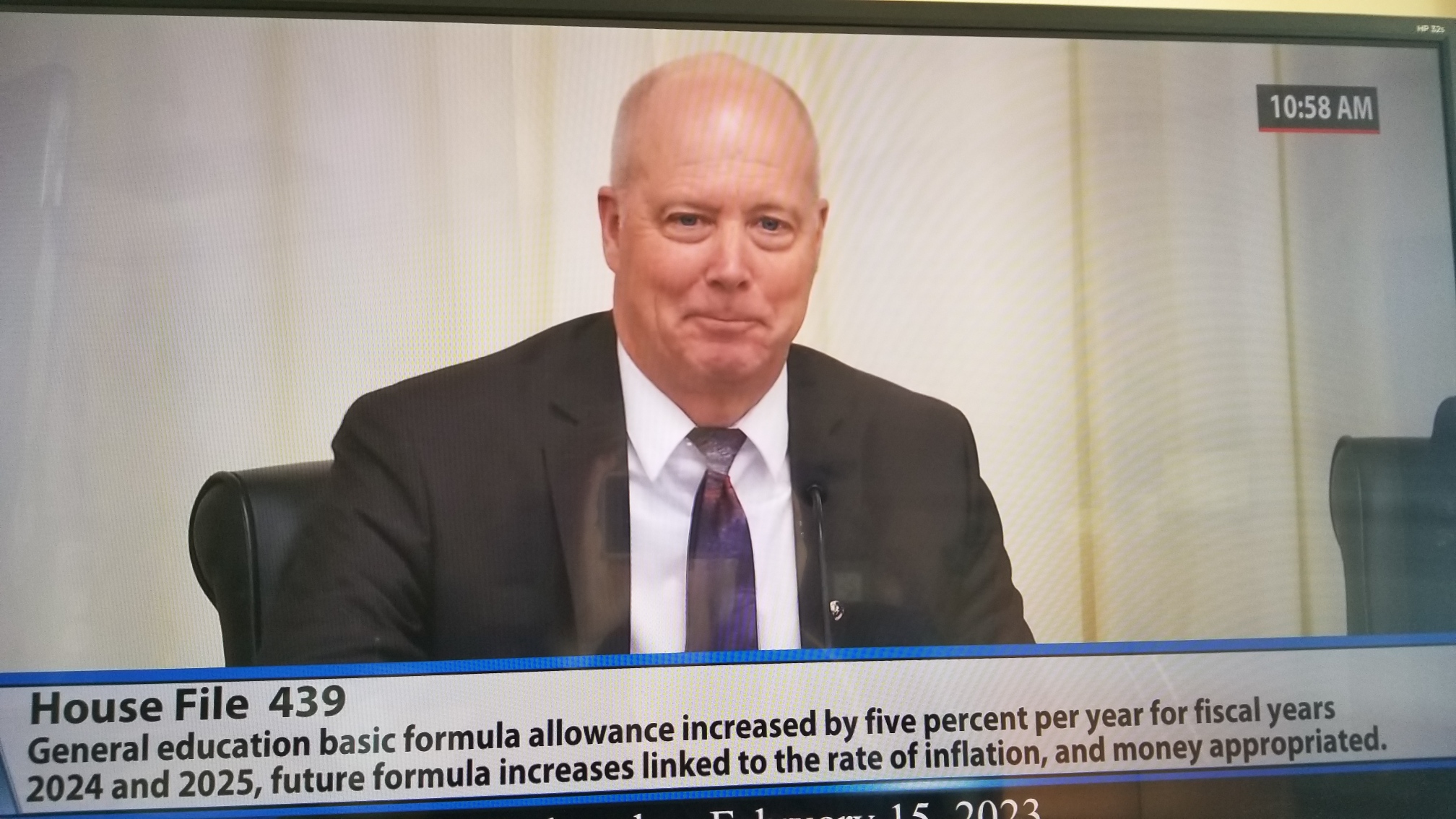MREA Executive Director Bob Indihar testified at the State Capitol last week in favor of HF439, one of MREA’s top funding priorities for the 2023 Legislative Session.
See the HF439 impact on districts with the 5% & 5% runs.
“MREA believes that putting money on the basic formula allowance will ensure funds are distributed most fairly per pupil throughout the state and allow districts the most flexibility to do what is best for their students,” said Indihar. “Also, tying the Basic Formula Allowance to an inflationary index will create a predictable and reliable funding stream where districts can plan long-term.”

Bob Indihar testifies at Capitol
Alongside other Minnesota education leaders, Indihar testified emphasizing that almost 100 MREA member districts rely mainly on basic formula dollars, because they do not have operating referendums to absorb the deficits caused by the state not keeping up with inflation on the basic formula allowance. Further, Indihar noted that even if a district has an operating referendum, the basic formula allowance is behind by 18% in the last two decades when including inflation.
Below is Indihar’s written testimony, which he modified slightly in-person in response to other testimony:
Chair Youakim and Members of the House,
I am Bob Indihar, Executive Director of the Minnesota Rural Education Association. We represent 235 rural districts in the state. I am here to testify in favor of HF439, our top funding priority.
As I travel the state, the number one request I hear from superintendents is to focus on making sure the basic formula allowance is increased by 5% & 5% and linked to inflation in future budget years. Our organization represents most of the nearly 100 districts who have no voter-approved Operating Referendum. They rely heavily on general Education formula dollars to run their district. While other districts have been able to overcome the shortfalls of their budgets with Operating Referendum revenue these districts are forced to make tough decisions about student supports and staffing due to having fewer dollars.
The reason this is so important this year is that inflation is hurting their bottom line more now than at any time in recent years. The tight labor market is causing salaries to rise, especially for our support staff positions. The average cost of subs has risen over 50% in the last 3 years. Rarely are health insurance renewals in line with regular inflations, in fact we have districts seeing 20-50% increases in recent years. We certainly don’t object to improving compensation and benefits for our staff as they are the core of what we do, but we need state aid to keep up with these realities. In addition to staffing, facility and capital costs are rising on everything from basic supplies to contractor services. Gas in 2020 was 2.17 and now is an average of 3.22. That is close to a 50% increase. According to the US department of Labor Bureau of Labor Statistics the CPI in 2021 and 2022 was 4.7% and 8.0% respectively. The 2023 data is not yet released.

Minnesota education leaders testify at Capitol.
While basic Formula allowance has been increased over the years it has not kept up with inflation. We know that from 2003 to 2023 the Basic Formula allowance is $1263/pupil less when adjusted for inflation. The buying power of state aid to districts has eroded by 18% over the last 20 years.
The most impactful funding stream to schools, to support the education of all students, is money on the formula. It’s fair and it’s stable. We see 90 cents of every dollar distributed equally to all students. Every district in the state gets the same $ base amount from the % increase on the basic formula allowance. The remaining 10 cents is distributed across compensatory, sparsity, sparsity transportation and declining enrollment revenue which are all tied to the basic formula allowance. Districts have the most flexibility with this revenue stream and can make decisions at a local level to do what is best for their district’s students.
Inflation is a real problem that districts must deal with. There is no business that can stay viable in Minnesota when they make a budget without an inflationary factor. Districts are forced to do this while they wait for the Legislature and Governor to finalize the E-12 budget, a decision that too often comes months after local district budgeting has begun and in some cases after required termination notices have gone out. This is not the way to be good stewards of the state’s core constitutional duty, to fund a system of public schools.
Districts need a predictable funding stream to make systemic changes over time. Without it all you can do is have short term initiatives. Tying the Basic Formula Allowance to inflation is needed to create a predictable funding stream for districts to operate for the long term.
Thank you for your time.
MREA will continue advocating for 5% & 5% on the formula. Members are encouraged to attend Advocacy Briefings for the most up-to-date session information.





